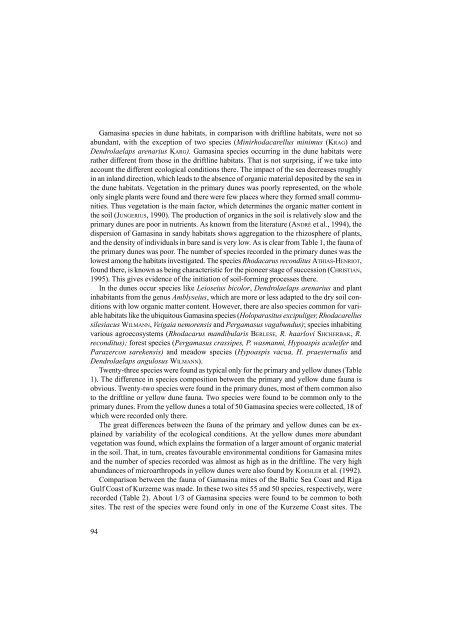spiders (araneae) of the fishpond eulittoral zone - European Society ...
spiders (araneae) of the fishpond eulittoral zone - European Society ...
spiders (araneae) of the fishpond eulittoral zone - European Society ...
Create successful ePaper yourself
Turn your PDF publications into a flip-book with our unique Google optimized e-Paper software.
Gamasina species in dune habitats, in comparison with driftline habitats, were not so<br />
abundant, with <strong>the</strong> exception <strong>of</strong> two species (Minirhodacarellus minimus (KRAG) and<br />
Dendrolaelaps arenarius KARG). Gamasina species occurring in <strong>the</strong> dune habitats were<br />
ra<strong>the</strong>r different from those in <strong>the</strong> driftline habitats. That is not surprising, if we take into<br />
account <strong>the</strong> different ecological conditions <strong>the</strong>re. The impact <strong>of</strong> <strong>the</strong> sea decreases roughly<br />
in an inland direction, which leads to <strong>the</strong> absence <strong>of</strong> organic material deposited by <strong>the</strong> sea in<br />
<strong>the</strong> dune habitats. Vegetation in <strong>the</strong> primary dunes was poorly represented, on <strong>the</strong> whole<br />
only single plants were found and <strong>the</strong>re were few places where <strong>the</strong>y formed small communities.<br />
Thus vegetation is <strong>the</strong> main factor, which determines <strong>the</strong> organic matter content in<br />
<strong>the</strong> soil (JUNGERIUS, 1990). The production <strong>of</strong> organics in <strong>the</strong> soil is relatively slow and <strong>the</strong><br />
primary dunes are poor in nutrients. As known from <strong>the</strong> literature (ANDRÉ et al., 1994), <strong>the</strong><br />
dispersion <strong>of</strong> Gamasina in sandy habitats shows aggregation to <strong>the</strong> rhizosphere <strong>of</strong> plants,<br />
and <strong>the</strong> density <strong>of</strong> individuals in bare sand is very low. As is clear from Table 1, <strong>the</strong> fauna <strong>of</strong><br />
<strong>the</strong> primary dunes was poor. The number <strong>of</strong> species recorded in <strong>the</strong> primary dunes was <strong>the</strong><br />
lowest among <strong>the</strong> habitats investigated. The species Rhodacarus reconditus ATHIAS-HENRIOT,<br />
found <strong>the</strong>re, is known as being characteristic for <strong>the</strong> pioneer stage <strong>of</strong> succession (CHRISTIAN,<br />
1995). This gives evidence <strong>of</strong> <strong>the</strong> initiation <strong>of</strong> soil-forming processes <strong>the</strong>re.<br />
In <strong>the</strong> dunes occur species like Leioseius bicolor, Dendrolaelaps arenarius and plant<br />
inhabitants from <strong>the</strong> genus Amblyseius, which are more or less adapted to <strong>the</strong> dry soil conditions<br />
with low organic matter content. However, <strong>the</strong>re are also species common for variable<br />
habitats like <strong>the</strong> ubiquitous Gamasina species (Holoparasitus excipuliger, Rhodacarellus<br />
silesiacus WILMANN, Veigaia nemorensis and Pergamasus vagabundus); species inhabiting<br />
various agroecosystems (Rhodacarus mandibularis BERLESE, R. haarlovi SHCHERBAK, R.<br />
reconditus); forest species (Pergamasus crassipes, P. wasmanni, Hypoaspis aculeifer and<br />
Parazercon sarekensis) and meadow species (Hypoaspis vacua, H. praesternalis and<br />
Dendrolaelaps angulosus WILMANN).<br />
Twenty-three species were found as typical only for <strong>the</strong> primary and yellow dunes (Table<br />
1). The difference in species composition between <strong>the</strong> primary and yellow dune fauna is<br />
obvious. Twenty-two species were found in <strong>the</strong> primary dunes, most <strong>of</strong> <strong>the</strong>m common also<br />
to <strong>the</strong> driftline or yellow dune fauna. Two species were found to be common only to <strong>the</strong><br />
primary dunes. From <strong>the</strong> yellow dunes a total <strong>of</strong> 50 Gamasina species were collected, 18 <strong>of</strong><br />
which were recorded only <strong>the</strong>re.<br />
The great differences between <strong>the</strong> fauna <strong>of</strong> <strong>the</strong> primary and yellow dunes can be explained<br />
by variability <strong>of</strong> <strong>the</strong> ecological conditions. At <strong>the</strong> yellow dunes more abundant<br />
vegetation was found, which explains <strong>the</strong> formation <strong>of</strong> a larger amount <strong>of</strong> organic material<br />
in <strong>the</strong> soil. That, in turn, creates favourable environmental conditions for Gamasina mites<br />
and <strong>the</strong> number <strong>of</strong> species recorded was almost as high as in <strong>the</strong> driftline. The very high<br />
abundances <strong>of</strong> microarthropods in yellow dunes were also found by KOEHLER et al. (1992).<br />
Comparison between <strong>the</strong> fauna <strong>of</strong> Gamasina mites <strong>of</strong> <strong>the</strong> Baltic Sea Coast and Riga<br />
Gulf Coast <strong>of</strong> Kurzeme was made. In <strong>the</strong>se two sites 55 and 50 species, respectively, were<br />
recorded (Table 2). About 1/3 <strong>of</strong> Gamasina species were found to be common to both<br />
sites. The rest <strong>of</strong> <strong>the</strong> species were found only in one <strong>of</strong> <strong>the</strong> Kurzeme Coast sites. The<br />
94
















